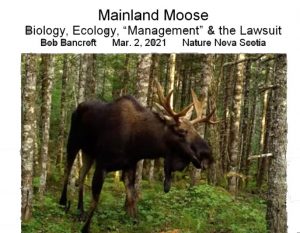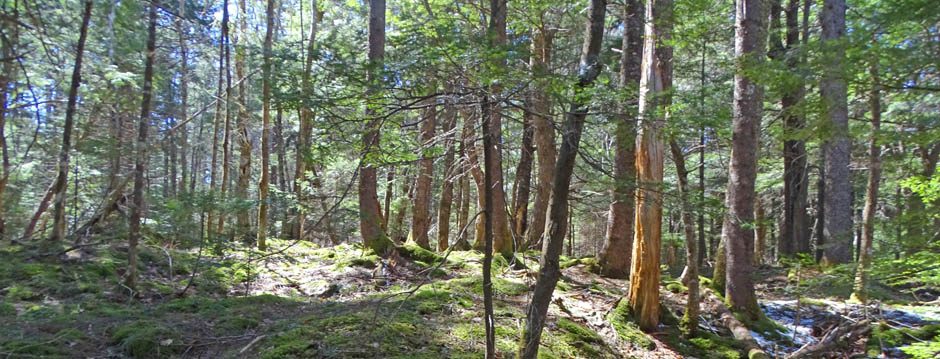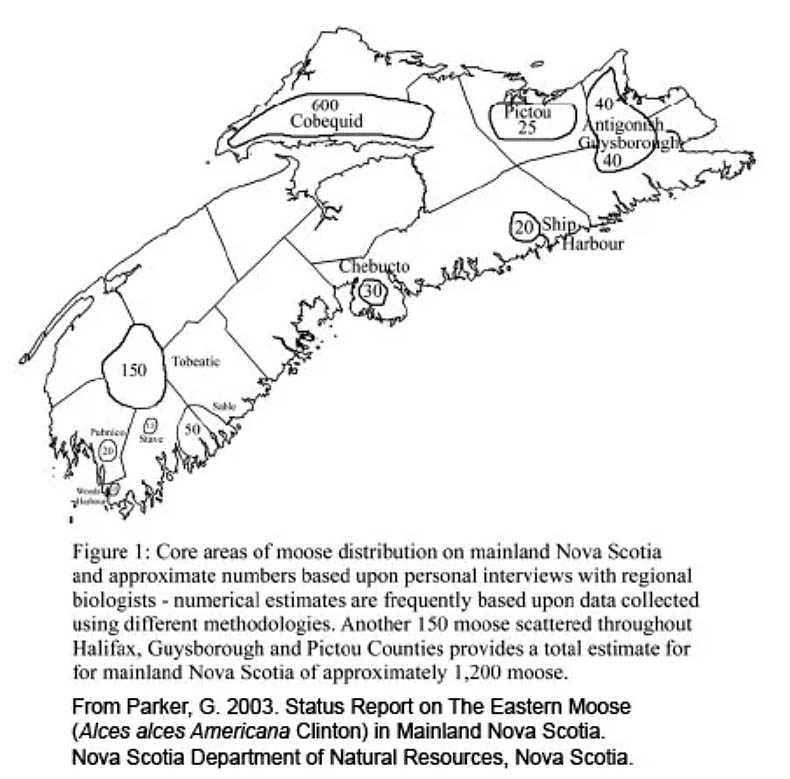| The pages and subpages on Moose:
MOOSE |
—–>To report observations of Mainland Moose to NRR: Go here <—–
| Bob Bancroft/Nature Nova Scotia on the Mainland Moose Nature Nova Scotia is the Federation of Naturalist Groups in Nova Scotia. Individual Nova Scotians can and many Nova Scotians do, hold individual memberships. The current President is Bob Bancroft who was a wildlife biologist with the NS Dept of Natural Resources for many years and “retired” early to be less hampered in his efforts to improve conditions for wildlife in NS. Bob is well known to Nova Scotians through his many public activities and regular interviews on CBC related to wildlife. Bob has a particular passion for the Mainland Moose.In a nutshell, Bancroft argues that the Mainland Moose are in bad shape because their habitat has deteriorated immensely under NS Government/Big Forestry management over many years and continuing today. In 2019, Bancroft spearheaded legal action, supported by NatureNS, the Halifax Field Naturalists and the Blomidon Field Naturalists, that would force the NS Government ” the to live up to its own laws” in relation to Endangered Species, including the Mainland Moose. They won the case ( see Saltwire May 29, 2020), and subsequently the government released its revised Mainland Moose Recovery Plan.Unfortunately, in practice, there remains very much more action that must be taken and that is not being taken to begin to reverse the decline of the Mainland Moose and the overall health of NS forests, the plethora of reassurances from Government and Big Forestry notwithstanding. In may ways, the state of the Mainland Moose reflects the State of our Forests in Nova Scotia (forests cover 75% of the NS landscape).With the very able assistance of Jess Lewis, Nature NS is undertaking a variety of research and public activities to improve our scientific knowledge and public awareness of the Mainland Moose.View these Nature NS documents: – Minister Rushton, Designate Core Habitat for the Mainland Moose – Protected on Paper Only: Mainland Moose 1 Year Post Judicial Review, pages 9-19 in State of Nature Report 2022  Nature Talks: Natural History of the Mainland Moose View You Tube Video – A look at the Mainland Moose, past present and future Set of 28 graphic posted by Nature NS on their Facebook page, March 2022. Also available as a slideshow on Google Docs – Nature Talks: Natural History of the Mainland Moose |
MAINLAND MOOSE CHRONOLOGY
It is estimated that there were 15,000 Eastern Moose in Nova Scotia when the Europeans arrived. Hunting reduced the number greatly by the mid-1800s.
Some restrictions on hunting were introduced in 1875 and the population increased for a period but then a decline began that continued until today in spite of a total ban on hunting since 1937.
The reasons are not well understood but involve a number of factors including increased incursion into wilderness moose habitat by forestry roads, mortality from a brainworm common to white-tailed deer, unidentified viral infection, high levels of the heavy metal cadmium, climate warming, acid rain, and loss of older growth coniferous and hardwood habitat to forest harvesting.
In 2003 the Mainland Moose numbered 1000-1200, distributed in nine core areas on the mainland. (Source: STATUS REPORT on The Eastern Moose (Alces alces americana Clinton) in Mainland Nova Scotia by Gerry Parker 2003).
The Mainland Moose was declared legally endangered in 2003.
They have not fared well since then and it appears there has been precipitous decline within the last 5 years or so.
The Recent Chronology
1995 to present, most recent at the top
2021
On Nov 26, 2021, the government released its revised Mainland Moose Recovery Plan. For context, view N.S. government releases mainland moose recovery plan at ‘critical juncture’ by Michael Gorman for CBC News Nov 26, 2021
An excellent summary of the context this plan, some of its components and its strong points and weak points are given in a post by NatureNS on Dec 15, 2021. View on NatureNS. View extracts copied onto this website. Also view 2021 Mainland Moose Recovery Plan excludes Chebucto Peninsula from areas of Core Habitat management 5Jan2021
Protests and legal actions related to logging of Mainland Moose habitat that had begun in the fall of 2020 continued in 2021. There were many news items related to Mainland Moose in 2021. Go to In the News 2021 and conduct a page search for “moose”.
2020
There were many news items related to moose in late 2020 following the ‘moose blockade’ and the subsequent arrest of protesters (cited below). Go to In the News 2020 and conduct a page search for “moose”.
News brief: Forest defenders arrested
RobertDevet in The Nova Scotia Advocate, Dec 15, 2020:
N.S. judge issues temporary injunction against forestry protest aimed at protecting mainland moose habitat
By Michael Tutton The Canadian Press on CTV News Dec 11, 2020
Protesters block logging road, say endangered moose at risk
Emma Smith, Phlis McGregor · CBC News Oct 28, 2020
BOB BANCROFT: Clearcuts squeeze out beleaguered mainland moose
Bob Bancroft in the Chronicle Herald, Nov 7, 2020 (image on WWNS) “Satellite images of clearcutting now spread like leprosy across the once-wooded body of Nova Scotia. The pace and scale of forest flattening on Crown land has set a horrible example for private lands, which also look like a measles rash from space.”
Top court rules province broke endangered species law
Francis Campbell on saltwire.com May 29, 2021. “The case marked the first time the Endangered Species Act, enacted in the province in 1999, was interpreted by a Nova Scotia court.”
2019
N.S. naturalists taking province to court
By Alexander Quon Global News January 29, 2019
The Endangered Species Act is meant to “provide for the protection, designation, recovery and other relevant aspects of conservation of species at risk.”
The groups allege that Lands and Forestry Minister Iain Rankin has failed to meet those requirements for 34 endangered, threatened, and vulnerable species including the mainland moose, wood turtle, and bank swallow.
Bancroft, who was a forest biologist with the Department of Natural resources for 18 years, says that the province did not adequately respond to two reports that called for the government to better enforce the Endangered Species Act.
The first was a 2015 paper from the East Coast Environmental Law Association that found the government had not fulfilled its legal obligation under the Act.
The second was a 2016 report from the province’s Auditor General Michael Pickup that examined conservation management and recovery.
Pickup wrote that at-risk species needed to be a greater priority for the then-Department of Natural Resources, as they were not fully managing “conservation and recovery of species at risk.”
Bancroft says he and the organizations in the action aren’t undergoing the process lightly.
“Normally, naturalists are a quiet bunch that like to admire nature. In this particular case, they’ve seen too much,” he said.
From high overhead, a sobering look at a moose population in deep trouble
Phlis McGregor · CBC News May 24, 2019. “Aerial survey results obtained by CBC show a steep decline of the endangered mainland moose in Nova Scotia”
Top court rules province broke endangered species law
Francis Campbell on saltwire.com, May 29, 2019. “The case marked the first time the Endangered Species Act, enacted in the province in 1999, was interpreted by a Nova Scotia court…The judge agreed with the complainants’ arguments that the lands and forestry minister had failed to implement the Endangered Species Acts as it pertains to six representative species, namely the mainland moose, the ram’s-head lady slipper, the Canada warbler, the black ash, the wood turtle, and the eastern wood pewee. ”
Spot an endangered mainland moose? Here’s why you should report it
Alex Cooke · CBC News July 6, 2019. “There could be fewer than 100 mainland moose remaining in Nova Scotia”
2018
Species at Risk in Nova Scotia #2 :Mainland moose battle ticks, ATVs and clear cuts
CBC News “This is the second in a series of stories from CBC’s Information Morning about species that are struggling to survive in Nova Scotia, and the people who have vowed to save them.” Audio (Information Morning interview with Clifford Paul)
2017
Moose sex corridor for endangered population expands to 1,200 hectares
CBC News · Posted: Mar 02, 2017 “Nature Conservancy of Canada expands wilderness corridor on Chignecto Isthmus by 95.5 hectares”
2015
Protected on Paper Only: Evaluation of Nova Scotia’s legal obligations to protect and recover mainland moose and other species-at-risk
Jamie Simpson, Steven Evans, & Lisa Mitchell, East Coast Environmental Law Association AND Environmental Law Students’ Society, Feb 2015
Nova Scotia’s mainland moose, listed as endangered in 2003, is an example of a species possibly threatened by the province’s shortcomings under the Act. In the mainland moose recovery plan, released 3 years later than legally mandated, DNR did not identify the core habitat necessary to sustain the remaining individuals, as is required under the Act. Nor did DNR attempt to chart a course in the plan to increase the number of moose to a sustainable level, also as required under the Act. Further, recovery plans are required to be evaluated every 5 years, and DNR has yet to evaluate the moose recovery plan since releasing it in 2007.
At the same time that DNR has failed to meet certain legal obligations to species at risk, it has moved forward with issuing new forest logging permits to forestry companies on lands that may overlap with habitat for some species at risk. In the absence of identified core habitat, the Endangered Species Act provides virtually no protection to species at risk from damaging forestry practices. ECELAW and ELSS are concerned that DNR’s resource extraction focus may be interfering with its responsibilities with respect to the province’s biodiversity and satisfying its legal obligations with respect to species at risk. Further, we note that Nova Scotia Environment (NSE) does not appear to be working with DNR to ensure species at risk are adequately conserved. As a result, NSE is not meeting its legal mandate to protect biodiversity, as it is required to do under the Environment Act.
We call on the province to take immediate action to comply with the Endangered Species Act. Identification of core habitat, and implementing actions already identified, is particularly important to the recovery of Nova Scotia’s species at risk. We also recommend that the Nova Scotia government move responsibility for species at risk from DNR to NSE, given NSE’s legislative mandate over the province’s biodiversity. A new path forward is necessary to give the public greater confidence that conservation laws are not undermined by DNR’s resource extraction mandate. Environment would be the logical department to be tasked with protecting biodiversity, given its mandate to do so under section 2 of the Environment Act.
2013/2014
McNeil, Jeffie. 2013. Action Plan for the Recovery of Eastern Moose (Alces alces Americana) in Mainland Nova Scotia.
Mainland Moose Recovery Team and Mersey Tobeatic Research Institute, Kempt, Nova Scotia. 21 pages. On the front page the “2014-2018” is written, presumably as the interval in which the Action Plan would be carried out.
This Action Plan identifies 5 inter-related tasks to fill these knowledge gaps and begin to work towards recovery.
Task 1- Provide reliable data on the distribution, abundance and population structure of mainland moose in Nova Scotia
Task 2- Develop tools to support decisions in forest management planning at multiple spatial scales for moose habitat requirements
Task 3- Undertake studies on threats and limiting factors to enable an understanding of the causes of moose population decline
Task 4- Provide and implement management strategies leading to the recovery of the moose population
Task 5- Raise public awareness, build partnerships and encourage stewardship of mainland moose in NS
2012
Endangered Mainland Moose Special Management Practices
Nova Scotia Department of Natural Resources
2007
Mainland Moose Continue to be Poached
DNR Press Release
Recovery Plan for Moose (Alces alces americana) in Mainland Nova Scotia
Nova Scotia Endangered Species Act Recovery Plan Series, Nova Scotia Department of Natural Resources.
2004
Road Density and the Potential Impact on Wildlife Species such as American Moose in Mainland Nova Scotia
Karen F Beazley et al.,2004. In Proceedings of the Nova Scotian Institute of Science Vol. 42: 339-357
Road density alone and road density in combination with habitat suitability index values predict the presence of moose pellets, whereas habitat suitability values alone do not. Thus, road density may be an indicator of moose habitat selection or effectiveness in mainland Nova Scotia.
Biodiversity conservation activities in Nova Scotia and elsewhere could focus on
– discouraging further road densities above 0.6 km/km2;
– protecting remaining roadless and low road density areas;
– minimizing new road construction, especially in natural areas;
– decommissioning and regenerating old logging roads;
– increasing buffer zones between natural areas and roads; and providing road crossings for wildlife in the form of under and overpasses.
The distribution, status and habitat associations of moose in mainland Nova Scotia
TV Snaith and KF Beazley In Proceedings of the Nova Scotian Institute of Science Vol. 42 Part 2: 263-317
Throughout the Nova Scotia mainland, small and fragmented moose populations remain at varying densities and may be limited or regulated by a number of factors including interspecific competition, disease, habitat alteration/loss, mineral toxicity/deficiency, predation, poaching, and resource availability. Ranging behaviour and habitat requirements vary according to environmental factors; however, moose require food and cover in sufficient quantity and of appropriate interspersion to meet their daily and seasonal needs. Mature forest with a well developed understory, and open areas with early successional vegetation provide forage, while dense forest provides cover from thermal stress and deep snow. Strategies for moose conservation, such as through forest management, should concentrate on the preservation and enhancement of habitat to meet the critical requirements of viable moose populations and the re-establishment of connections among discrete populations.
2003
STATUS REPORT on The Eastern Moose (Alces alces americana Clinton) in Mainland Nova Scotia
by Gerry Parker
2003
The mainland (eastern) moose is listed as endangered under the Endangered Species Act.
1995
Moose Herd Perseveres
by: Mark Pulsifer in coNSservation
When Europeans first settled Nova Scotia’s coastline, moose were the largest member of the deer family. They shared the forests with one other deer species, the woodland caribou. White-tailed deer had been absent from this province for many years*, returning in the latter part of the 19th century. For a brief time, all three deer species co-existed. However, by the early 1920s caribou disappeared from our woodlands and barrens because of 300 years of market hunting, poaching, and habitat loss.
Similar population pressures have affected moose herds throughout Nova Scotia, resulting in dramatically fluctuating population levels. Some of these declines were so severe that the Provincial Game Commissioner’s Report of 1910 indicated that moose numbers had approached extinction twice since 1800. Even during the first half of the 20th century, moose numbers continued to fluctuate dramatically because of winter range conditions, herd size, and carrying capacity of the habitat.
Today’s moose herd size appears to be stable and even increasing in areas such as the Cape Breton Highlands and west of Kejimkujik National Park. Traditional population strongholds, such as the Cobequid Hills and the Pictou-Antigonish Highlands, have experienced significant declines in moose numbers. Prior to and during these declines (throughout the 1960s and 1970s), moose numbers were high enough to support an annual moose hunt. Declining hunter success prompted the closure of the mainland hunt after 1981.
*Deer were likely not present in NS &NB before settler times.
1981
An Evaluation of Moose Habltat in South Western Nova Scotia
by Paul D. Tufts, NS dept of Lands and Forests Thanks to BW for obtaining this important but now forgotten document Some extracts:
Introduction
The following survey was conducted in response to public concern over uranium explorations by Aquitaine Company of Canada Limited and over possible mining operations in the inaccessible portion of South Western Nova Scotia. Of immediate concern was the proposed construction of an access road into the inaccessible Moosehide Lake area of Digby County and the impact of access and mining on a remnant moose population in that area.
Conclusions
It can be concluded that a relatively dense population of moose is confined to a relatively small wilderness area with no access. The area is very fragile in that the soils are very shallow. Mining disturbances would certainly destroy its value to wildlife.
Since the exploration lease takes in most of this sensitive pocket wilderness, it is obvious that would have a detrimental effect on wildlife, especially on a population that has no where else to go.
Poaching of this slow reproducing moose population would certainly result from the construction of an access road and, therefore, threaten these isolated animals.
The small size of this unique area cannot provide for both mining and wildlife interests. Decision-makers will have to make a choice.
Recommenendations
Since this study was conducted with wildlife interests in mind, it 1s recommend that mining operations and access roads be discouraged 1n this unique wilderness area.
It 1s also recommended that the area be declared and protected as one of the last “wilderness” areas in Nova Scotia.
It 1s recommended that more studies be conducted 1n the area to establish a more exact population density.
 Click on image to enlarge |
 |




